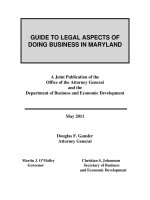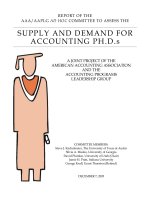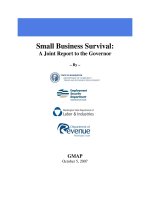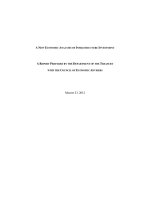A Joint Publication of the Office of the Attorney General and the Department of Business and Economic Development docx
Bạn đang xem bản rút gọn của tài liệu. Xem và tải ngay bản đầy đủ của tài liệu tại đây (751.27 KB, 88 trang )
GUIDE TO LEGAL ASPECTS OF
DOING BUSINESS IN MARYLAND
A Joint Publication of the
Office of the Attorney General
and the
Department of Business and Economic Development
May 2011
Douglas F. Gansler
Attorney General
Martin J. O’Malley Christian S. Johansson
Governor Secretary of Business
and Economic Development
Acknowledgments
Laila K. Atallah, Principal Counsel, Office of the Attorney General, Department
of Business and Economic Development
Ellen S. Cooper, Principal Counsel, Antitrust Division, Office of the Attorney
General
Jennifer Wazenski, Principal Counsel, Office of the Attorney General,
Department of
Natural Resources
William Gruhn, Principal Counsel, Consumer Protection Division, Office of
the Attorney General
Steven Johnson, Principal Counsel, Office of the Attorney General, Department
of the Environment
Colleen A. Lamont, Assistant Attorney General, Department of Business and
Economic Development
Melanie Senter Lubin, Commissioner, Securities Division, Office of the Attorney
General
David M. Lyon, Principal Counsel, Office of the Attorney General, Department
of Assessments and Taxation
Craig A. Nielsen, Principal Counsel, Office of the Attorney General, Department
of Agriculture
Brian L. Oliner, Principal Counsel, Office of the Attorney General,
Comptroller of the Treasury
David M. Porter, Assistant Attorney General, Department of Business and
Economic Development
W. David Rawle, Assistant Attorney General, Department of Business and
Economic Development
David Tillman, Director of Communications, Department of Business and
Economic Development
Elizabeth H. Trimble, Principal Counsel, Office of the Attorney General,
Department of Labor, Licensing and Regulation
Carolyn I. Uchendu, Administrative Aide, Office of the Attorney General,
Department of Business and Economic Development
DISCLAIMER
This booklet is for informational purposes only and does not
constitute legal services or representation. Further, this booklet is not an
exhaustive treatment of the legal obligations of Maryland businesses, but
rather focuses on only those matters regulated by State agencies. For
specific and complete legal advice, please consult with a practicing
attorney who is knowledgeable about Maryland law and is familiar with
the relevant details of your situation.
Despite every effort to ensure the accuracy of this booklet’s contents,
some errors may appear. Moreover, laws can change quite rapidly, and
court interpretations of laws often vary. Therefore, no guarantee can be
given as to the accuracy and completeness of any information provided in
this booklet. The Attorney General’s Office and the Department of
Business and Economic Development hereby specifically disclaim any
liability for loss incurred as a consequence of any material presented in
this booklet.
i
TABLE OF CONTENTS
I. BUSINESS ORGANIZATION
A. Introduction 1
B. Corporation 1
C. General Partnership 4
D. Limited Liability Partnership 5
E. Limited Partnership 6
F. Limited Liability Limited Partnership 8
G. Limited Liability Company 9
II. FOREIGN BUSINESS OPERATIONS IN MARYLAND
A. Introduction 10
B. Independent Operations 11
C. Joint Venture 14
III. MERGERS UNDER MARYLAND LAW 15
IV. SECURITIES LAW
A. Introduction 15
B. Registration of Securities 16
C. Exemptions from Registration Requirement 17
D. Preemptions from Registration Requirement 18
V. MARYLAND TAXATION
A. Introduction 18
B. Tax Registration 19
C. Maryland Sales and Use Tax 20
D. Maryland Corporation Income Tax 21
E. Maryland and Local Personal Income Tax 22
F. Maryland and Local Real Property Tax 23
G. Local Personal Property Tax 24
VI. LABOR AND EMPLOYMENT LAW
A. Introduction 25
B. Employment Eligibility 26
C. Equal Employment Opportunity 26
D. Safety and Health Standards 28
ii
E. Workers’ Compensation Insurance 29
F. Wage Laws 30
G. Employment-Related Tax Considerations 32
H. Employee Concerted Activity 33
I. Fringe Benefits 33
J. Workforce Services 34
VII. BUSINESS ASSISTANCE AND FINANCING PROGRAMS
A. Introduction 35
B. Business License Information System 36
C. Domestic Business Assistance Programs 36
D. Domestic Business Financing Programs 38
E. International Business Assistance and Financing Programs 49
F. Employee Training Programs 54
G. Tax Credit Incentive Programs 55
VIII. ASSISTANCE TO AGRICULTURE BUSINESSES
A. Maryland Agriculture 56
B. Selling Maryland Agriculture 57
C. Protecting Maryland Agriculture 59
IX. NATURAL RESOURCES LAW
A. Shoreline Development 59
B. Forest Development 60
C. Licenses 60
X. ENVIRONMENTAL LAW
A. Introduction 63
B. Air and Radiation Management Administration 64
C. Land Management Administration 65
D. Water Management Administration 67
XI. CONSUMER PROTECTION LAW
A. Consumer Protection Act 70
B. Uniform Commercial Code 70
C. Services of the Consumer Protection Division 71
iii
XII. FRANCHISE LAW
A. Introduction 73
B. Registration and Disclosure 74
XIII. ―BUSINESS OPPORTUNITY‖ LAW
A. Introduction 74
B. Registration and Disclosure 75
XIV. ANTITRUST LAW
A. Introduction 76
B. Enforcement 76
C. Concepts of Antitrust Law 77
D. Prohibited Activities 78
E. Trade Associations 82
F. Conclusion 82
G. Business Review Procedure 82
1
I. BUSINESS ORGANIZATION
A. INTRODUCTION
State law governs the formation of businesses in the United
States; there is no federal law regulating general business forms.
Normally, a U.S. business will organize under the law of the state in
which its main office or facility is located. This is not a requirement,
however; a business may choose to organize under any state law,
and then comply with the laws for foreign corporations in those
states in which its operations are actually located. (See Section II
below, ―Foreign Business Operations in Maryland.‖)
Maryland’s business laws are flexible and serve well those
businesses that have chosen to establish operations in Maryland. To
encourage the creation and expansion of businesses, Maryland
offers several flexible options for organizing business activity. For
all of the business forms listed below, all papers are filed with the
State Department of Assessments and Taxation (―SDAT‖) at the
following address:
State Department of Assessments and Taxation
301 West Preston Street 8
th
Floor
Baltimore, Maryland, 21201
Telephone: (410) 767-1340
Documents may be filed with SDAT by mail. Filings can also
be done on an expedited basis by facsimile transmission (service
within 24 hours) or by personal delivery (immediate service). The
filing fees are relatively nominal; call SDAT to get up-to-date fee
information, or visit SDAT’s Web site at:
Maryland recognizes the following business forms:
B. CORPORATION
1. Formation
A Maryland corporation may be formed by
simply having at least one adult (an ―incorporator‖)
file articles of incorporation with SDAT.
2
2. Features
a. Taxation
A corporation is taxed as a separate
entity; it files its own tax return and pays taxes
without regard to the tax status of the
individual shareholders. However, if the
corporation distributes a portion of its after-tax
income to its shareholders in the form of
dividends, each shareholder will pay a separate
tax on the dividend received.
b. Liability
A shareholder of a corporation is not
personally liable for the acts or obligations of
the corporation. However, a small business that
chooses the corporate form should be aware
that banks and other commercial lenders
understand the liability advantages of the
corporate structure and will often require the
personal guarantees of corporate shareholders
as a condition of making a loan to the
corporation.
3. Articles of Incorporation
SDAT provides standardized fill-in-the-blank
examples for corporations on its above mentioned
website. However, the use of that standardized form
is optional. The articles of incorporation must include
the following information:
name and address of each incorporator
name of corporation
purpose for which corporation was
formed (can be as general as ―to engage
in any lawful activity‖)
address of corporation’s principal office
in Maryland
name and address of corporation’s
resident agent
3
authorized number, class, and par value,
if any, of shares
a description of each class of stock, if
applicable
number and names of corporation’s
initial directors
The articles of incorporation also include
provisions governing the basic rights of shareholders
and defining the authority of directors. Since
shareholder information is not filed with SDAT, the
ownership of the corporation does not become a
matter of public record with the State.
4. Corporate Name
A corporation’s name must include one of the
following words, or its abbreviation:
―company,‖ if not preceded by ―and‖ or
―&‖
―corporation‖
―incorporated‖
―limited‖
5. Resident Agent
A resident agent is a person or entity that serves
as a business organization’s ―point of contact‖ in the
state for the purpose of receiving legal notices
addressed to the business. The address of a resident
agent for a corporation and all other entities must be
an actual physical location and not simply a post office
box. A corporation’s resident agent must be one of the
following:
a citizen of Maryland who resides in
Maryland
a Maryland corporation
4
6. Corporate Directors and Officers
Maryland requires that each corporation have
at least one director. The directors oversee the
corporation and elect the officers (the senior
management), who manage the day-to-day business
activities. The qualifications required of directors are
set by the corporation, not by the State.
In addition to its directors, a corporation must
have as officers at least a president, a secretary, and a
treasurer. A corporation may have other officers,
including any number of vice presidents. If the
corporation’s bylaws permit, one person may hold
more than one office, except that one person may not
be both president and vice president. Moreover, a
person holding more than one office may not act in
more than one of those capacities when executing,
acknowledging, or verifying certain documents.
C. GENERAL PARTNERSHIP
1. Formation
There are no filing formalities required to form
a general partnership. Any unincorporated
association of two or more persons, acting as co-
owners, that is set up to engage in a business activity
for profit is a general partnership.
2. Features
a. Taxation
Profits, losses, and control are
proportionately divided among the partners.
Although the partnership must file an
informational tax return, it is not taxed as a
separate entity; rather, taxable income, losses,
deductions, and credits are passed through on a
pro-rated basis to each of the partners. Each
partner is taxed directly on its share of the
5
partnership’s net income, whether that income
is distributed or not.
b. Liability
Each general partner is personally liable
for all the acts and obligations of the
partnership. However, under Maryland law, a
corporation (foreign or domestic) may be a
partner, so for the corporate partner, only its
corporate assets would be at risk.
D. LIMITED LIABILITY PARTNERSHIP
1. Formation
A limited liability partnership (―LLP‖) is
formed when a general partnership registers as an LLP
by filing a certificate of limited liability partnership
with SDAT.
(A limited partnership may also register as a
limited liability partnership. See Section F below,
entitled ―Limited Liability Limited Partnership.‖)
2. Features
A limited liability partnership functions in the
same way as a general partnership, with one
exception: in a limited liability partnership, the
general partners are not individually liable for the
obligations incurred by the partnership or by other
partners unless a partner is guilty of negligence or
misconduct.
3. Certificate of Limited Liability Partnership
The certificate must contain the following
information:
name of the LLP
purpose for which the LLP was formed
address of the LLP’s principal office in
Maryland
6
name and address of the LLP’s resident
agent
4. Limited Liability Partnership Name
The name of the limited liability partnership
must contain either the words ―limited liability
partnership‖ or the abbreviation ―L.L.P.‖ or ―LLP.‖
5. Resident Agent
An LLP’s registered agent must be one of the
following:
a citizen of Maryland who resides in
Maryland
a Maryland corporation
a Maryland limited liability company
E. LIMITED PARTNERSHIP
1. Formation
A limited partnership is a partnership of two or
more persons, with at least one general (―managing‖)
partner and at least one limited (―investing‖) partner.
A limited partnership is formed when all of the
general partners file a certificate of limited partnership
with SDAT.
2. Features
a. Taxation
A limited partnership is taxed in the
same way that a general partnership is taxed.
b. Liability
Under usual partnership law, a general
partner is personally liable for the acts and
obligations of the limited partnership, while a
limited partner is not. However, Maryland
7
offers three other features to protect partners in
limited partnerships from liability:
A corporation may serve as the
general partner, thus exposing
only corporate assets to risk.
Limited partnership agreements
may be drafted to indemnify
partners, employees, and agents
of the limited partnership for all
acts except fraud and reckless
conduct.
A limited partner may act as an
officer, director, or shareholder of
the corporate partner without
subjecting himself to liability as a
general partner, so long as a
creditor does not have a
―reasonable belief‖ that, based
upon his conduct, the limited
partner is instead a general
partner.
3. Certificate of Limited Partnership
The certificate must contain the following
information:
name of limited partnership
address of limited partnership’s principal
office in Maryland
name and address of limited
partnership’s resident agent
name and address of each general
partner
latest date upon which the limited
partnership is to dissolve
4. Limited Partnership Name
The name of the limited partnership must
contain either the words ―limited partnership‖, or the
abbreviation ―L.P.‖ or ―LP‖. In addition, the name of
8
the limited partnership may not contain the name of
the limited partner, unless that is also the name of a
general partner, or unless the business of the limited
partnership had been carried on under that name
before the admission of that limited partner.
5. Resident Agent
A limited partnership’s resident agent must be
one of the following:
a citizen of Maryland who resides in
Maryland
a Maryland corporation
F. LIMITED LIABILITY LIMITED PARTNERSHIP
1. Formation
As mentioned in Section D above, a limited
partnership may, like a general partnership, register as
a limited liability limited partnership (―LLLP‖). The
limited partnership registers by doing two things:
a. Including in its certificate of limited
partnership the following information:
name of the LLLP
purpose for which the LLLP was
formed
address of the LLLP’s principal
office in Maryland
name and address of the LLLP’s
resident agent
and
b. Using the words ―limited liability limited
partnership‖ or the abbreviation
―L.L.L.P.‖ or ―LLLP.‖
9
2. Features
All of the legal provisions that govern a general
partnership that has registered as a limited liability
partnership also govern a limited partnership that has
registered as a limited liability limited partnership.
Thus, this form provides the same limited liability for
the limited partners, but will also provide limited
liability for the general partner in the same fashion
that a limited liability partnership does for the
partners of a general partnership.
G. LIMITED LIABILITY COMPANY
1. Formation
A limited liability company (―LLC‖) is formed
by filing articles of organization with SDAT.
2. Features
An LLC is an unincorporated business
organization with at least one ―member.‖ Members
may be individuals, corporations, partnerships, or
other LLCs.
a. Taxation
An LLC is normally taxed in the same
way a partnership is taxed; however, businesses
considering using the LLC form should consult
tax counsel about the availability and method of
making an election of corporate or partnership
tax status; see Internal Revenue Service Form
8832.
b. Liability
An LLC is similar in function to a
partnership, but offers the same liability
protection for its members as a corporation does
for its stockholders.
10
3. Articles of Organization
The articles of organization must contain the
following information:
name of the LLC
purpose for which the LLC was formed
address of LLC’s principal office in
Maryland
name and address of LLC’s resident
agent
4. Limited Liability Company Name
The name of the limited liability company must
contain either the words ―limited liability company‖
or the abbreviation ―L.L.C.‖, ―LLC‖, ―L.C.‖, or ―LC.‖
II. FOREIGN BUSINESS OPERATIONS IN MARYLAND
A. INTRODUCTION
The State of Maryland welcomes direct foreign investment in
terms of the ownership and active management of business
enterprises. (―Foreign‖ businesses are those that are organized
under the laws of another country, the United States, or another
state in the United States.) Foreign investors may organize their
business activities in Maryland in a variety of ways that are
designed to provide sufficient flexibility to fit the needs of any
particular business venture. However, the final determination will
depend upon a number of legal and tax considerations.
Initially, the foreign business must determine whether it
plans to operate independently, or in a joint venture with another
U.S. firm. If the foreign business is planning to operate
independently, it may simply establish a branch office in Maryland.
Alternatively, it may choose to operate through a wholly owned
subsidiary corporation organized under the laws of a state in the
United States.
11
B. INDEPENDENT OPERATIONS
1. Branch Office
A foreign corporation, partnership, or limited
liability company may establish a branch office in
Maryland by registering or qualifying with the State
Department of Assessments and Taxation (―SDAT‖).
a. Foreign Corporations
(i) Registration (Interstate and Foreign
Business)
If a foreign corporation wishes to engage
in interstate or foreign business operations in
Maryland, it must register with SDAT. To
register, the foreign corporation must:
certify its address; and
certify the name and address of its
resident agent in Maryland.
(ii) Qualification (Intrastate Business)
If a foreign corporation wishes to engage
in intrastate business operations in Maryland, it
must qualify with SDAT. To qualify, the
foreign corporation must:
certify its address; and
certify the name and address of its
resident agent in Maryland; and
Note: if a foreign corporation is qualified
to do intrastate business in Maryland, it need
not also register to do interstate or foreign
business in Maryland.
b. Foreign Limited Liability Company (LLC),
Limited Liability Partnership (LLP), or Limited
Liability Limited Partnership (LLLP)
12
If a foreign LLC, LLP, or LLLP wishes to
engage in interstate, intrastate, or foreign
business in Maryland, it must register with
SDAT. To register, the foreign LLC, LLP, or
LLLP must submit an application to SDAT
containing:
The name of the foreign LLC, LLP,
or LLLP, and if different, the name
it proposes to use in Maryland to
do business
The name of the state under which
laws it was formed
The date of formation of the
foreign LLC, LLP, or LLLP
A general description of the
business to be transacted in
Maryland
The name and address of its
resident agent in Maryland, and a
statement that SDAT may act as
the resident agent for the foreign
LLC, LLP, or LLLP if it has no
resident agent
The address of the office that it is
required to have under the laws of
the state in which it was formed,
or if there is no such requirement,
the address of its principal office
c. Foreign Limited Partnership (LP)
If a foreign LP wishes to engage in
interstate, intrastate, or foreign business in
Maryland, it must register with SDAT. To
register, the foreign LP must submit an
application to SDAT containing:
The name of the foreign LP, and if
different, the name it proposes to
use in Maryland to do business
13
The name of the state or country
under which laws it was formed
The date of formation of the
foreign LP
A general description of the
business to be transacted in
Maryland
The name and address of its
resident agent in Maryland, and a
statement that SDAT may act as
the resident agent for the foreign
LP if it has no resident agent
The address of the office that it is
required to have under the laws of
the state in which it was formed,
or if there is no such requirement,
the address of its principal office
The name and address of each of
its general partners
d. Maintaining Qualification.
Once the foreign business is registered or
qualified, it must only file an annual personal
property report (plus a $300 fee for a
corporation doing intrastate business) to
maintain its registration/qualification. In
addition, a foreign corporation must maintain
its resident agent in Maryland.
e. Contacting Comptroller.
Depending on the type of business and
the presence of employees in Maryland, the
foreign business may need to contact the Office
of the Comptroller for purposes of sales tax and
employment tax withholdings. (See other
sections of this Guide.)
14
2. Subsidiary Corporation
Instead of using a branch office, many foreign
businesses choose to operate in Maryland though a
subsidiary corporation formed under the laws of
another state in the United States. One benefit of this
arrangement for foreign national businesses is that as a
general rule, only the assets of the U.S. subsidiary are
placed at risk in the U.S. operations. In addition, the
use of a separate U.S. subsidiary will help to clarify
what income will be subject to U.S. taxation.
The parent corporation, as the sole shareholder
of the subsidiary, will decide who the subsidiary’s
director is, and through the director, will oversee
senior management. Maryland permits a subsidiary
corporation to have only one director, who may be a
citizen or resident of another state or nation.
Please refer to Section I for information on
setting up a business in Maryland; a foreign business
would follow the same procedures in setting up its
Maryland subsidiary. In addition, the foreign business
must also comply with the laws for foreign
corporations in Maryland (and in any other state in
which the foreign corporation has located operations.)
C. JOINT VENTURE
A ―joint venture‖ is an arrangement through which a foreign
business enters into an enduring relationship with a U.S. business
for the purpose of sharing resources in a common enterprise in
order to produce together goods or services. Joint ventures between
foreign businesses and U.S. businesses are common today and we
believe that the number of joint ventures will increase markedly in
the future as more businesses pool their resources to serve world
markets.
In Maryland, joint ventures may be formally structured in
several ways:
15
The two businesses may each contribute capital
to a newly created corporation in exchange for
an equity interest. Each of the co-venturers
would then be a shareholder with voting rights
in deciding who serves on the board of
directors.
Alternatively, the foreign business and the U.S.
business, either directly or through wholly
owned subsidiaries, may enter into a
partnership agreement and operate the joint
venture as a general or limited partnership.
Finally, the joint venture may be structured as a
limited liability company (―LLC‖) with each of
the parties, either directly or through
subsidiaries, becoming members of the LLC and
managing the newly formed venture according
to an operating agreement.
There are various tax and legal issues relating to the
preferred form of organization in particular cases, but the business
goals of the venture may be accomplished in any of these formats.
III. MERGERS UNDER MARYLAND LAW
One last example of the flexible options offered by Maryland law is
in the area of mergers. Under Maryland law, a Maryland business entity
may merge into or with one or more foreign business entities. Likewise,
Maryland law permits foreign business entities to merge with business
entities organized under Maryland law.
IV. SECURITIES LAW
A. INTRODUCTION
The Maryland Securities Act and related regulations allow
companies, large and small, to raise capital in Maryland in a manner
consistent with the protection of investors against investment fraud.
Like the federal securities laws, Maryland law requires a company
offering securities to provide potential investors with full and
complete disclosure about the company, so that investors are able to
make informed investment decisions. Unlike some states, Maryland
does not pass on the merits of an investment offering.
16
Securities come in all shapes and sizes. Corporate stock or
limited partnership interests are well-known types of securities;
however, limited liability company interests, notes issued in loan
transactions, viatical settlement agreements, and other investment-
type contracts may also be securities.
B. REGISTRATION OF SECURITIES
The Securities Division of the Attorney General's Office is the
agency that enforces the Maryland Securities Act. Any offer or sale
of a security in Maryland must be registered with the Securities
Division, unless the Maryland Securities Act or federal law exempts
or preempts the specific type of security or transaction from the
registration requirement.
1. General
In most cases, an issuer has a number of choices in the
manner of registration or exemption of its securities offering.
There is also more than one way for the selling agent to
qualify to sell the offering.
Many of the registration and exemption provisions in
the Maryland statute relate directly to the federal securities
laws and the regulations of the U.S. Securities and Exchange
Commission (―SEC‖), so that an issuer of securities may
readily coordinate compliance with both Maryland and
federal law. In many large national offerings, Maryland
regulation is minimized or eliminated in favor of SEC
oversight. In other local or regional offerings, Maryland
takes a primary role in review of the offering.
2. Streamlined Procedure
In many cases, issuers who are registering their
securities offering may take advantage of a streamlined
procedure for coordinating state registration with SEC
registration. For example, offerings under Regulation A of
the SEC rules may be registered with several states
concurrently using this coordinated procedure.
17
3. Small Company Offering Registration (SCOR)
For small company offerings that meet certain
conditions, the Small Company Offering Registration
(―SCOR‖) program is available. Under SCOR, certain small
business issuers may raise capital in the public market
without incurring the expense of a typical securities
registration. The SCOR program offers several advantages to
the small entrepreneur:
The disclosure document is in a ―plain English‖
format
Requirements for expensive audited financial
statements and exhibits are relaxed
With less involvement of lawyers and
accountants, offering expenses are reduced
An entrepreneur may coordinate a SCOR
registration at the state level with a Regulation
D, Rule 504 limited offering at the federal level
Under SCOR, shares received by investors are not
restricted, general solicitation may be used, and the issuer
may sell up to $1 million in securities in any 12 month period.
Before offering securities under SCOR, the issuer must file
the completed Form U-7 and accompanying documents with
the Securities Division, and pay the filing fee. An attorney in
the Division will work with the company to help ensure that
the SCOR disclosure document meets the requirement of the
state securities law that the company disclose to potential
investors all information material to an investment decision.
C. EXEMPTIONS FROM REGISTRATION REQUIREMENT
The following types of offerings are exempt from the
registration requirement:
Certain offers to existing security holders
A ―limited offering‖ or ―private placement‖ usually
requires only the filing of a short notice form with the
Division
Certain very small offerings do not require any filing
at all
18
Of course, the issuers of these securities are still subject to the
law’s requirement of full disclosure to potential investors.
D. PREEMPTIONS FROM REGISTRATION REQUIREMENT
The following types of offerings are pre-empted from the
registration requirement:
Offers of certain national exchange listed securities
sold by a Maryland registered broker-dealer
Offerings of Investment Company securities made
pursuant to federal securities Regulation D, Rule 506
These two exemptions are ―self-executing‖ and do not
require any filing with the Securities Division. Of course, the
issuers of exempt or preempted securities are still subject to
the law’s requirement of full disclosure to potential investors.
For more information regarding the requirements of the
Maryland Securities Act, registration, exemption or preemption
provisions generally or the SCOR program in particular, please
contact:
Maryland Securities Division
200 St. Paul Place
Baltimore, MARYLAND 21202-2020
Telephone: (410) 576-7050
or
www.oag.state.md.us – website
V. MARYLAND TAXATION
A. INTRODUCTION
In Maryland, the principal State taxes are:
Sales and use tax
Corporation income tax
Personal income tax
Real property tax
19
The major local revenue sources for the counties and
Baltimore City include:
Real property tax
Personal property tax
Local income tax on individuals
Overall, the total tax burden imposed on businesses
operating in Maryland and on Maryland residents is lower than in
most states in the United States.
B. TAX REGISTRATION
1. State Tax Registration – Combined Registration
Application
Maryland provides one-stop business registration
online through the State Comptroller’s web site at
www.marylandtaxes.com. The Combined Registration
Application meets the requirements for most State taxes,
including sales and use tax, income tax withholding, and the
unemployment insurance tax. Combined Registration
Applications and instructions may be obtained from the
Clerk of the Circuit Court in each Maryland county, at any
branch of the State Comptroller’s Office, on-line at
/>rcra/entrance.asp, or directly from:
Taxpayer Registration Assistance Center
(TRAC)
Room 206
301 W. Preston Street
Baltimore, Maryland 21201
Telephone: (410) 767-1300
If the Combined Registration Application is prepared
completely and accurately, the registration may generally be
completed within one hour if the applicant appears in person;
it will generally be completed within 72 working hours if
submitted by fax (410-767-1571) and within 14 working days
if submitted by mail.









